Ever been a ‘regular’ at a restaurant? You go there often enough that you’ve built relationships with the staff — they know your name, your favorite table, how you like your steak, etc. Brick and mortar businesses like this understand that truly knowing the customer is vital to establishing loyalty and encouraging repeat purchases.
With many brands transitioning to having an online presence, it is increasingly difficult for them to truly know their customers. Fear not, AdWords offers Audience Insights to digital advertisers so customer details are not such a mystery.
What are AdWords Audience Insights?
AdWords Audience Insights are reports that the platform offers to aid advertisers in understanding their customer base while guiding them towards finding new and relevant audiences to target. The “audiences” the report refers to can be found across the advertiser’s Web, Customer Match, App, and YouTube remarketing lists.
The insights presented are based on data collected by Google to each particular audience’s demographics, interests, locations, and device usage allowing advertisers to make informed adjustments to their digital advertising strategy.
Why should AdWords users use them?
AdWords Audiences enable advertisers to:
Assess the progress of their current campaigns and ad groups
These insights provide actionable feedback that can be used to make informed adjustments to your advertising strategy. For example, in the event that a significant proportion of your users are categorized into a particular affinity audience you could target them by layering that respective affinity audience on top of the “All Visitors” segment.
Gain a deeper understanding of their customer base
The more advertisers understand each customer segment and their respective intent (e.g. in-market), affinity (e.g. interests), demographic (e.g. age/language spoken), location (e.g. Canada) and device usage data (e.g. desktop), the better they can tailor their ads and advertising strategy around that particular segment.
Identify areas with growth potential
Once advertisers understand their customer base better, they can expand their ad group targeting and adjust bids specifically at driving those potential new customers (with similarities to the sample segment) towards the top of their business’s funnel.
The insights reported become especially valuable when the audience happens to be the company’s highest revenue generating customer segment. Hence, potential top-line growth.
It’s worth adding that the majority of business structures tend to isolate each department from one another giving them their respective priorities and limiting any cross-functional interaction:
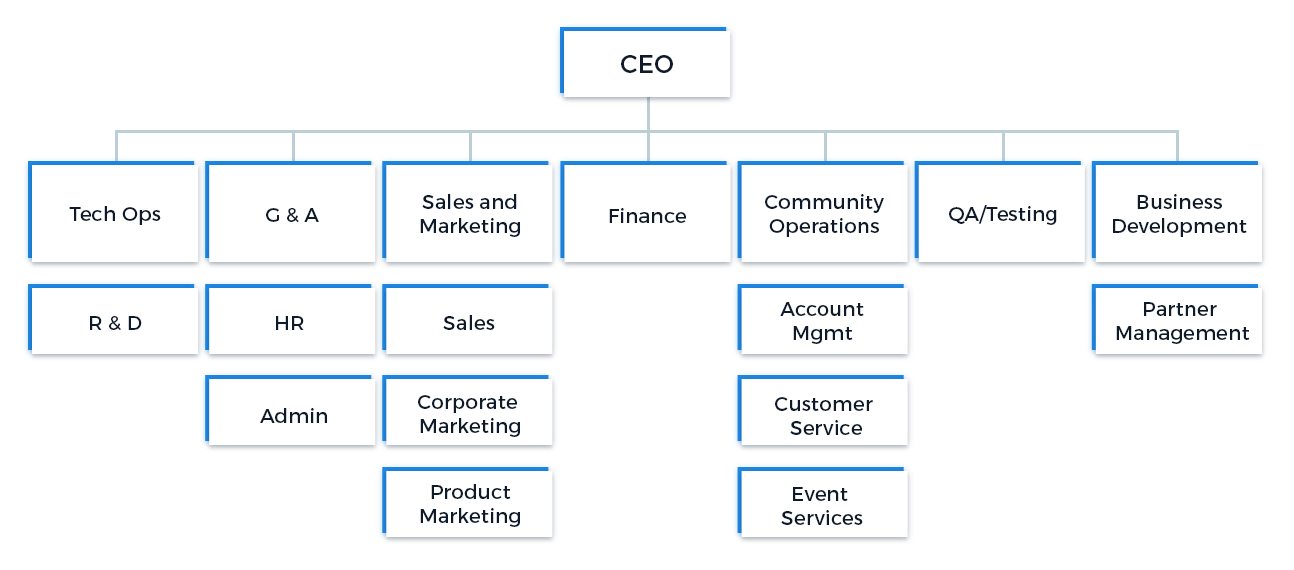
However, the information afforded by Google through Audience Insights is often highly valuable to departments beyond Marketing itself and is, therefore, worth sharing. Strong inter-departmental communication will improve efficiency and enhance iteration of feedback loops which teams can use towards product or service improvements.
Limitations of Audience Insights
For all its benefits, AdWords Audience Insights does have limitations, especially when compared to Facebook Audience Insights. Facebook boasts 2.07 billion monthly active users (logged into the platform in the last 30 days):
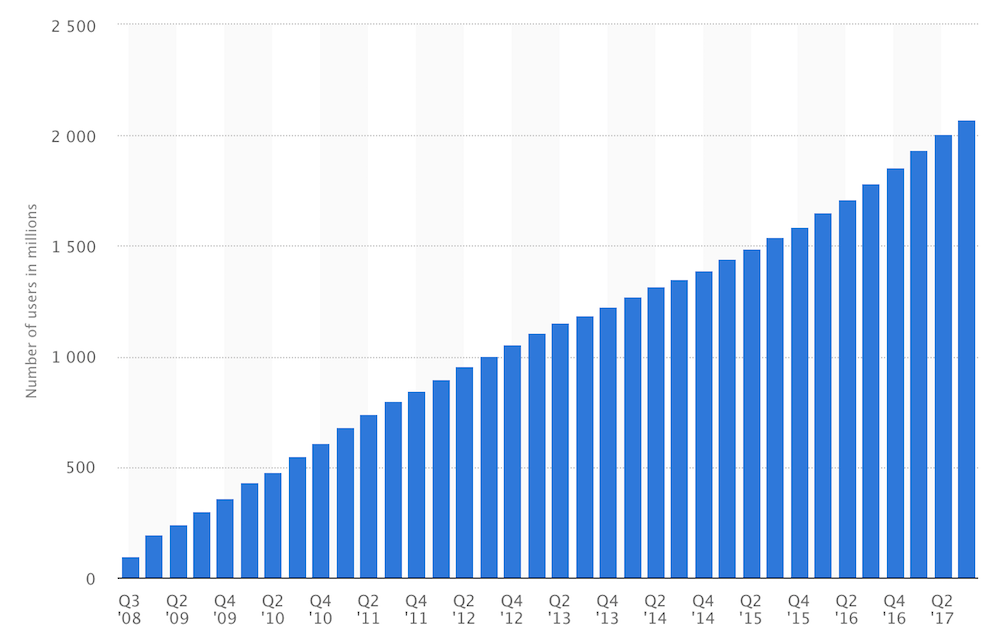
Additionally, the nature of the platform ensures that its users willingly provide their personal information inclusive of not only their demographic data but also their relationship status, level of education, workplace, nature of relationships, etc.
Facebook actively tracks its user’s behavior and collects important interest data based on their user’s activities while on the platform in combination with data related to its users’ offline behavior. This, coupled with the amount of data collected on each user given the frequency of use, affords marketers a lot of useful information at a higher level of granularity not yet available by AdWords Audience Insights:

How can Google AdWords Audience Insights be applied?
Before we discuss how to apply the insights, let’s establish what each insight category entails:
In-Market Audiences
To be classified as “In-Market” the user must be actively searching and comparing products or services online.
Google considers the user’s search history, clicks on related ads and subsequent conversion events, content consumption patterns including type and frequency, social activity, and other information when qualifying users to its “In-Market” categories:
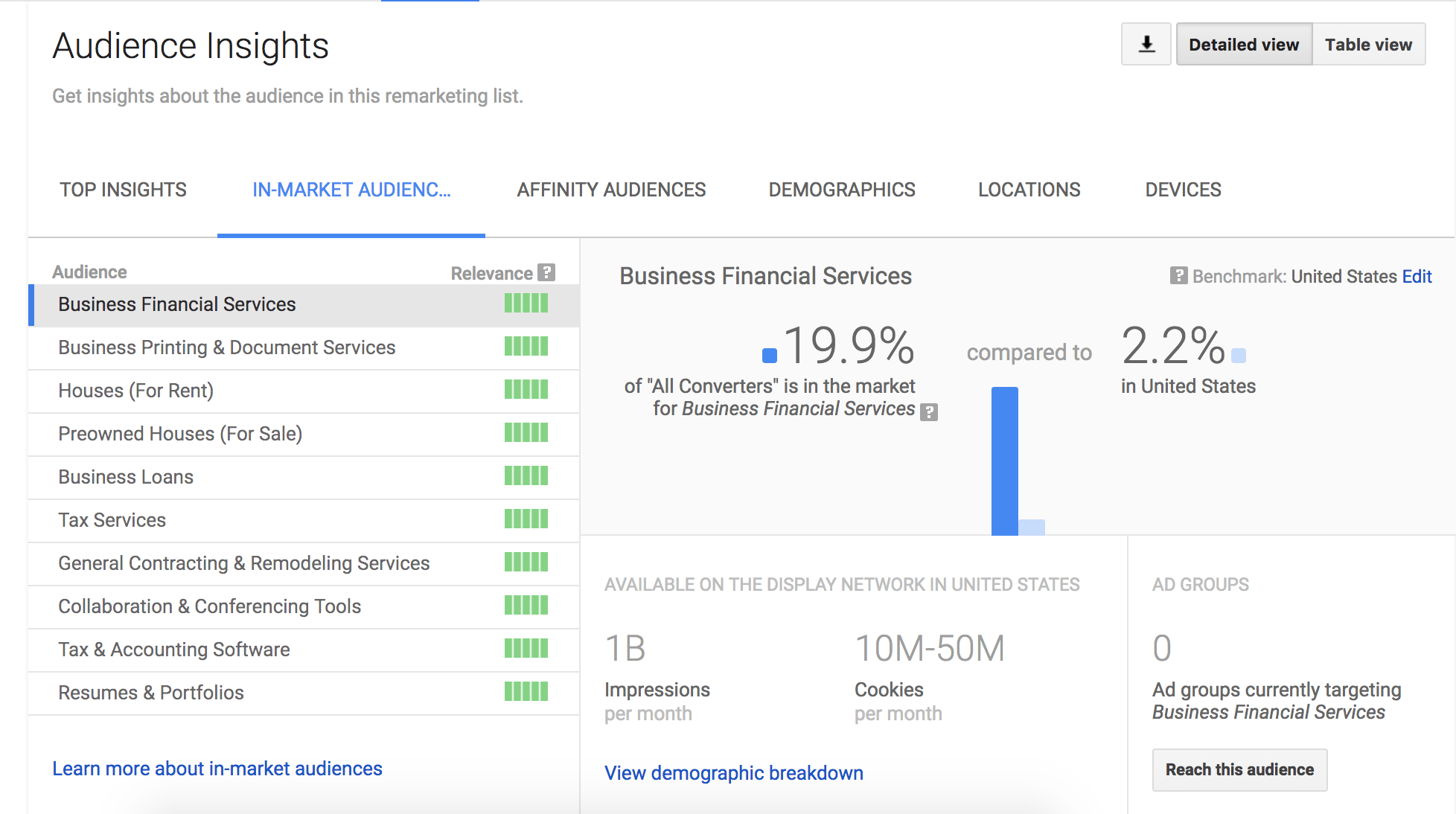
Targeting users that Google has classified as part of the “In-Market” audience offers the advertiser an opportunity to present that user with the right offer at the right time given that they’re “On the market” for a product or service like yours. Plus, combining In-Market audiences with remarketing can drive highly-qualified leads to your site more efficiently.
Affinity Audiences
Google takes a longer-term perspective when determining a users’ affinities. For affinity targeting, Google collects all of the interest-related information available from the user’s app activity on their Android (via Advertising ID) or iOS (via IDFA) mobile devices as well as the user’s browser activity (via DoubleClick cookies) to gain a sense of each particular user’s overall identity.
Keep in mind this data may not represent the entirety of your customer base given that some users may be using alternate operating systems (i.e. Firefox OS, Windows 10 Mobile) or may have never interacted with DoubleClick’s servers:
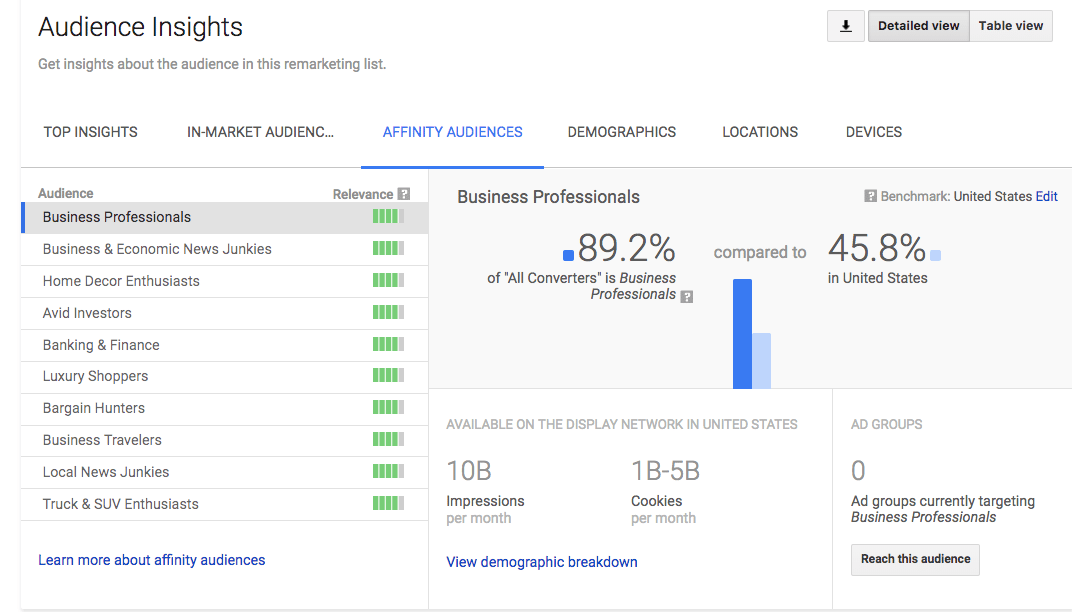
Affinity targeting can be somewhat analogous to TV ads and can render excellent results in driving brand awareness to a captivated audience actively engaging with topics in direct relation to your products or services.
Demographics
Google derives demographic information such as gender, age, and parental status directly from the information that users voluntarily provide through other Google accounts (i.e. Google+, YouTube and Gmail, etc). It also collects data from users’ web browsing and app activity on mobile devices while household income is determined by public data provided by the I.R.S.
And in the event that a user isn’t signed into a Google account while searching online, Google will infer the user’s demographics based solely on their activity while on Google properties or the Display Network:
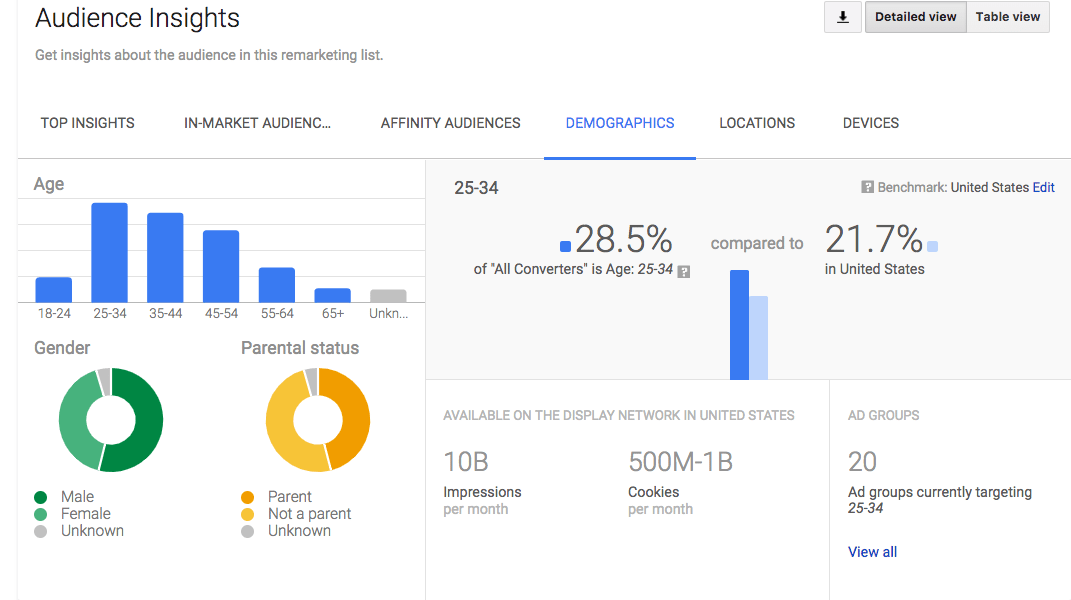
Demographic targeting is a great option when focusing your campaign on a narrow set of potential users that are within a specific age range, gender, household income or parental status. This sort of laser-focused targeting inherently excludes those users outside of the chosen demographic group from seeing your ads.
It’s important to note that the “unknown” demographic category tends to be considerably large and will inevitably include some if not many of your targeted demographic. Therefore, the decision to include or exclude the category must be carefully considered.
Additionally, some websites on the Display Network opt out of demographic targeting altogether. So, to show your ads on those sites the advertiser must ensure to select the “Unknown” demographic category.
Locations
AdWords uses a number of factors in determining a user’s location including the IP address associated with the computer or Wi-Fi network being used, GPS signal, bluetooth signal, and cell tower (device permitting):
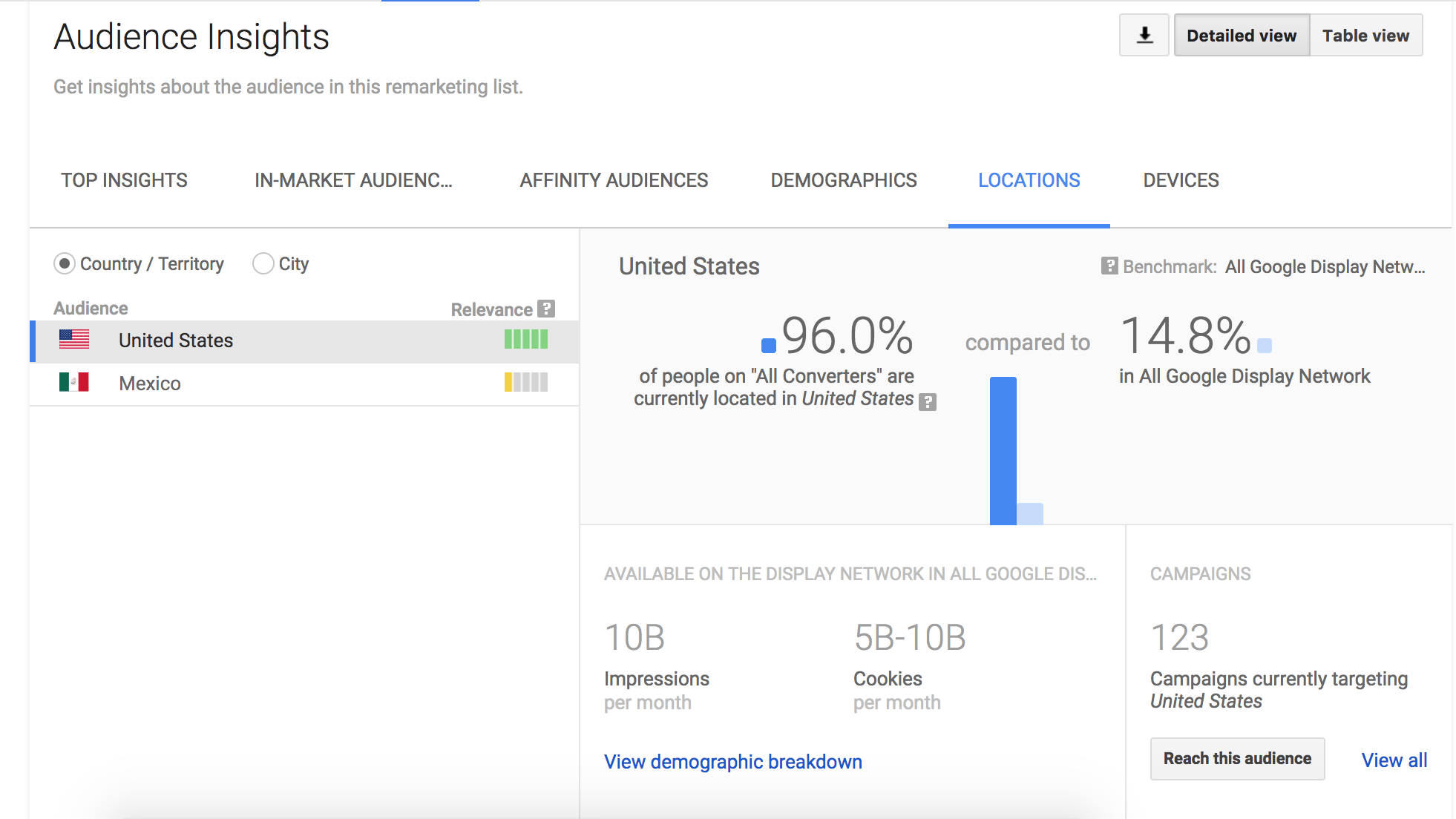
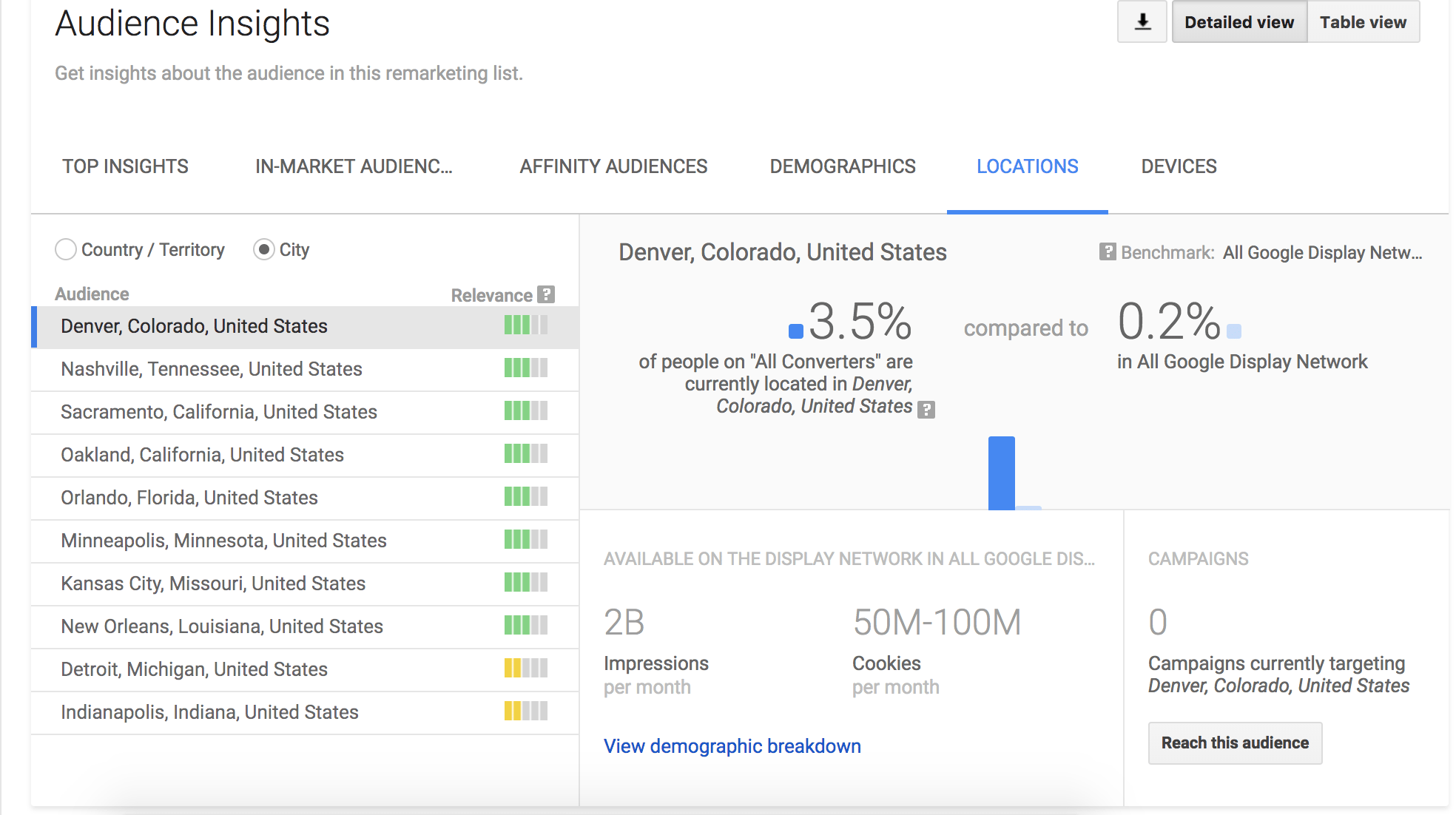
Devices
Devices are determined by the device used at the time of browsing and broken down into three categories: Desktop, Mobile, and Tablet. Insights into device preference can inform strategy beyond targeting as well.
For example, a large proportion of your remarketing list is found to use mobile over other devices. In this case, it would be imperative to liaise with the Product and Engineering teams to ensure the site offered a mobile-friendly user experience:
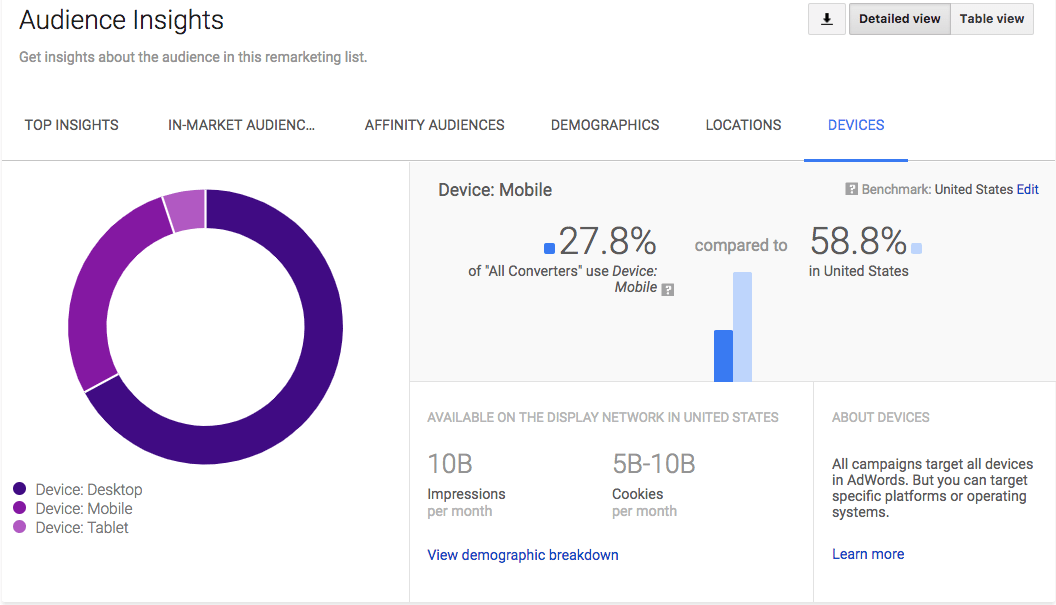
Check out this link to access lists that highlight exactly how Google has segmented audiences within the above categories.
Consider this scenario
Prior to extracting any actionable insights from AdWords Audience Insights it’s necessary to ensure that all conversion events are clearly defined. In case that hasn’t taken place yet, here’s a link to help set up AdWords conversion tracking.
Now that we’ve covered how Google collects its data and categorizes its users for Audience Insights, let’s observe an example of how we can interpret and strategize around that data.
Let’s assume that you’re in charge of paid acquisition at an automated investment service firm and are interested in attracting high-quality leads that are actively looking to invest money for their retirement. Your site receives thousands of visitors each day and, thanks to your conversion tracking in place, you can determine exactly how many of them click on the “About” section, the “Investment Methodology” section, and those that have completed the “Risk Tolerance” questionnaire.
Additionally, each visitor’s behavior is tracked by the cookie on their browser which ensures that each visitor that completed the “Risk Tolerance” questionnaire is categorized under the “All Converters” remarketing list (along with that particular visitor’s in-market status, affinity, demographic, location and device information) to form part of the larger audience.
Data that you have collected has helped you determine that the users found in the “All Converters” remarketing list are the highest quality leads given their level of engagement. AdWords Audience Insights will help you find audiences that share similarities with those users in the “All Converters” remarketing list.
How to access AdWords Audience Insights
- Click on Shared Library from AdWords’ side navigation.
- Click “View” beneath the Audiences option.
- From the Audiences table, select the remarketing list you’re interested in expanding on.
- The top insights about that specific remarketing list will be displayed. To get detailed insights click on the tabs found in the top navigation such as: In-Market Audiences, Affinity Audiences, Demographics, Locations & Devices.
Take your campaign targeting to the next level
To summarize, Audience Insights offers an opportunity to gain a deeper understanding of your customers: who they are, what they’re interested in, what their intentions may be and customize your ads — resulting in higher conversion rates. It’s a powerful tool that allows advertisers to see and exploit potential opportunities that would otherwise be hard to recognize given the digital veneer that separates marketers from their customers. I hope you have found this post helpful and wish you success with this feature and its dynamic applications.
To turn ad clicks into conversions, create dedicated, fast-loading post-click pages for every offer. See how to provide all of your audiences with unique post-click landing pages by signing up for an Instapage Enterprise demo today.
About the author
Alex Del Salto is a marketing specialist that defines growth-strategies and executes on tactics for startups — specializing in user acquisition, CRO analytics, customer nurturing, and behavioral targeting. As an SEM Analyst at Growth Pilots, he collaborates with the Social Media Advertising team on maximizing the ROAS across multiple marketing channels for B2C and B2B client accounts. To reach him directly feel free to contact him via LinkedIn or Twitter.

See the Instapage Enterprise Plan in Action.
Demo includes AdMap™, Personalization, AMP,
Global Blocks, heatmaps & more.
